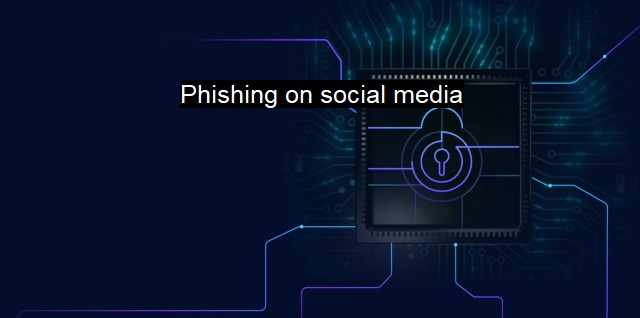What is Phishing on social media?
Social Media Phishing: How Cybercriminals Strategically Target and Deceive Users for Personal and Corporate Gain
In the ever-evolving field of cybersecurity, one menace that has steadily grown over the past several years is “phishing” on social media. This concept, which is now ubiquitous in the immediate realm of digital technology, has come to represent a new frontier in the fight against various forms of cybercrime. Gaining a deeper understanding of this phenomena can help individuals protect their sensitive information online.To appreciate the depth of 'Phishing on social media', let's start by decoding the term 'Phishing'. It is a fraudulent practice employing psychological manipulation to deceive individuals into revealing confidential information, such as passwords or card details, by disguising as trustworthy entities. Originating in the context of email systems, phishing attempts initially leveraged phony emails tricking recipients into divulging personal information. But as technology advanced swiftly, and people's lives became more intertwined with online platforms, cybercriminals followed suit, invading the sphere of social networks and giving birth to a new hazard: "Phishing on social media."
Social media phishing is the process whereby attackers use social networking sites, like Facebook, Twitter, or LinkedIn, to amass personal information from unsuspecting users. Here's how it works: An attacker crafts and posts seemingly genuine like friend requests, messages, posts, or even advertisements mimicking authentic companies, organizations, user-profiles, or services. These deceptive posts include malicious links leading to phishing websites appearing legit. Once a user clicks on these links, they're commonly directed to a sham login page that prompts them to enter sensitive data, like their login credentials. Subsequently, the attacker can use this information for nefarious actions, such as stealing identities, making unauthorized transactions, or launching targeted attacks.
The vast trove of personalized information shared on social media makes it a favored hunting ground for phishers. They can easily drape their illicit actions in layers of believable data making their sinister bid most effective. It's a steadily increasing trend. STOZ (Simple to Z) Communication, the parent company of social media threat defense Blade, revealed a 70% increase in social media phishing from Q3 of 2018 to Q4 of the same year. The issue lies in our carefree attitude towards social media which tends to ensure a lack of cybersecurity measures and thereby providing an easy target for attackers.
In order to carry out a successful phishing campaign, attackers often employ techniques of social engineering—that is, manipulating individuals using their cognitive biases towards performing actions that may not be in their best interest. This could range from enticing unsuspecting users through themed holiday discount offers to creating a sense of urgency by posing as their banking institution and suggesting a security breach.
One cannot avoid mentioning the role of antivirus applications. Contemporary antivirus solutions have evolved beyond simple virus detection; they are now much more dynamic and wide-reaching in their protective capabilities. They incorporate anti-phishing tools that shield users from potential phishing attacks on social media. These cutting-edge antivirus applications are equipped with sophisticated algorithms and heuristic analysis to understand and promptly detect phishing attempts and malicious links. They provide real-time protection, blocking access to identified phishing sites, thus thwarting any attempt to steal sensitive data.
It’s important to remain vigilant regarding the ever-increasing issue of phishing on social media, an area where cybersecurity intersects with many of our daily online activities. As appealing as it is for us to share and communicate freely on social platforms, we must bear in mind these spaces have become equally attractive for cybercriminals perfecting deception art. Use of strong and unique passwords, refraining from clicking on dubious links, and staying educated about the latest phishing scams, coupled with an advanced antivirus solution, will significantly minimize the risk of falling prey to such malicious intent.

Phishing on social media FAQs
What is phishing on social media?
Phishing on social media is a cyber attack technique used to retrieve sensitive information like login credentials or financial information by creating fake posts or messages that seem legitimate.How does social media phishing work?
Social media phishing works by creating a message or post that appears to come from a trusted source. This message urges the user to click on a link or enter their login details. The link leads the user to a fake website that resembles the real one, which tricks them into giving away confidential information.How can I protect myself from social media phishing?
You can protect yourself from social media phishing by never clicking on links from unknown sources, not sharing login information, enabling two-factor authentication, and installing antivirus software. It's also important to scrutinize any email, social media, or text message that asks for personal information.What should I do if I suspect a social media phishing attempt?
If you suspect a social media phishing attempt, do not engage with the message or post. Do not click on any links that it may contain. Instead, report the post or message to the social media platform and delete it, then immediately change your login credentials. If you have inadvertently clicked on a link or provided login information, contact your bank or credit card company to alert them to the situation.| | A | | | B | | | C | | | D | | | E | | | F | | | G | | | H | | | I | | | J | | | K | | | L | | | M | |
| | N | | | O | | | P | | | Q | | | R | | | S | | | T | | | U | | | V | | | W | | | X | | | Y | | | Z | |
| | 1 | | | 2 | | | 3 | | | 4 | | | 7 | | | 8 | | |||||||